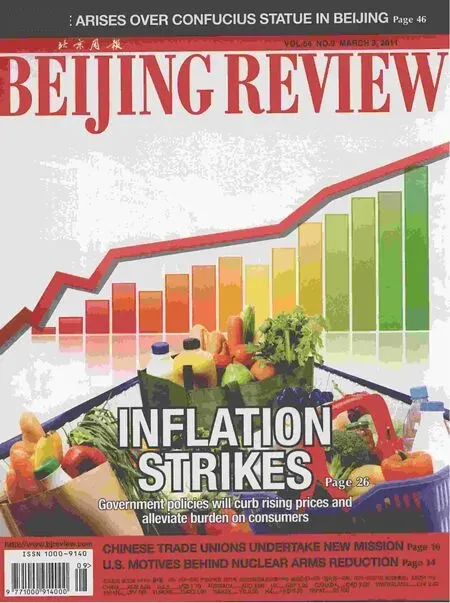MARKET WATCH
2011-12-24LIUYUNYUN
MARKET WATCH
OPINION
Soothing Local Woes
It has been a pressing task for China to address acute concerns over local government indebtedness. The problem has sounded an alarm for the Chinese economy as the country’s local government debts amounted to a dizzying 10.7 trillion yuan ($1.69 trillion) by the end of 2010. It is imperative to reform the fiscal system and tackle the imbalance between local and central budgets.
While local governments are not allowed to directly take loans or issue bonds,many have set up special investment vehicles to fi nance large infrastructure projects.
Worries abound that they may experience acute strains as 4.6 trillion yuan ($726.7 billion), or 43 percent of their debts, are expected to come due in 2011 and 2012. The risks are looming since it is hard for those projects to generate instant returns and cover their debts.
A number of local governments depend heavily on land transfer fees as a major source of finance. But the real estate market has been tapering off as policymakers stepped up a stringent clampdown on the sector.
In 2011, land transfer fees of 130 cities across the nation totaled 1.86 trillion yuan($294.38 billion), down 13 percent from 2010. How to hold debt risks at bay and wean off local governments’ reliance on land transactions is a major dilemma.
In China, prolonged capital shortages have forced local governments to raise mounting debts. The root cause lies in the imbalance between central and local government fi nances.
As a result of the fiscal system reform in 1994, local governments must hand over a majority of their revenues to the Central Government. The reform delivered a strong boost to the Central Government’s fiscal capacities, while it left local governments in a weaker fi nancial position.
While they have a limited source of tax revenues, local governments have to shoulder costs of the enormous public welfare.To make ends meet, the local governments have to rely on land transfer fees and borrow a pile of debts.
The permanent solution for China is to reform its fi scal system and expand tax revenues of local governments.
The country can learn some experiences from the United States, which has three levels of government—federal government,state governments and local governments.The governments at those three levels have clearly defined expenditures and revenues,as well as decision-making powers over their own fi nance.
Despite the huge political and economic differences between the two countries, the U.S. fi scal system should be a good example for China. There are several suggestions for the policymakers as they try to reform the fi scal systems.
First, China has already started resource tax reform as an effort to conserve resources and protect the environment. It would be helpful if China can follow international practices and allow central and local governments to share the resource tax revenues at a fi xed proportion.
Second, China could consider collecting environmental tax, and the revenues should go to local governments since they are responsible for local environment management.
Third, the government should deepen the property tax reform and explore new tax categories to bolster the war chests of local governments.
THE MARKETS
Auto Euphoria
While Chinese auto manufacturers reel from a slow market, their overseas counterparts are glittering with buoyant sales in China.
German auto giant Volkswagen sold 313,036 Audi cars in China in 2011, soaring 37 percent from the year before. The bright performance allowed China to shift to the company’s number one spot in terms of markets.
“This result exceeded our sales forecast significantly,” said Peter Schwarzenbauer,a board member for sales and marketing of Audi. He added that Audi continues to see strong growth potential in China.
In another move, Swedish auto guru Volvo Car Corp. said its China sales jumped 54 percent in 2011, while its sales in North America and Europe grew 23 percent and 13.1 percent, respectively.
U.S. General Motors and its joint ventures in China sold around 2.55 million vehicles in China last year, growing 8.3 percent year on year.
Huawei Shines
Huawei Technologies Co. Ltd., China’s largest mobile network equipment maker, is bursting with vitality thanks to robust device sales.
The Shenzhen-based company said its device sales jumped around 50 percent year on year to reach $6.7 billion last year, with handheld device shipments exceeding 150 million units, up 30 percent.
While it still relies on its network equipment business as a pillar source of revenues,Huawei has been making inroads into consumer devices because of buoyant global demand for smart phones and tablets.
In 2011, Huawei joined hands with China Telecom to launch a series of smart phones including the C8500 and C8650, which have become market hits.
Wan Biao, head of the fi rm’s device unit,said around 65 percent of the handsets were purchased through wholesales by telecom operators, while the remainder was sold via online retail sales.
This is an edited excerpt of views of Zhang Monan, a researcher at the State Information Center, published onChina Securities Journal
